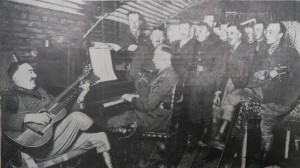Three Chords and the Truth

Canadian Motor Machine Gun Brigade officers sing-along. Lieutenant Colonel W.K. Walker with guitar.
(Canada Illustrated Weekly, May 11, 1918, page 163)
Art in Storytelling
Its poetry…words…wordsmithing…art…cadence…metaphor. Its heartache and longing, joy and celebration, finding a path, search and discovery, its about others and…its about self.
How many times have I rummaged about the endless papers of forced lyrics and find amongst them the ones that have remained? Sometimes we try too hard to repeat our talents, some days best left to drift ’til the tide brings us back to shore. With chords to the side of the papers C – F – G / G – C – D the fingers re-find the melody…three chords and a voice. Life’s experience…story.
Time reaches to you…Just like a willow
I have been asked about and encouraged to write about story-telling…where does it come from, how do you find the words? And just like this evening when I have started on one path and found that path wanting, I shift course through the brambles to these words. Perhaps no better, but these words, this night I feel. That feel is heart…the drum within our person…one heart one soul, words from oneself that may perhaps take another to paper and pen, keys and keyboard, soundtrack or film. These are voices to be encouraged.
And it took me back to something
Placing self in story, the adventurer’s adventure becomes personal and relatable. I search former days and recall words that provide the compass points of today…I see your face so clearly once again…I’ve been walking for most of the night…Wouldn’t it be nice to find…each lyric about someone or someone’s someone.
Three chords and the truth are not my words but those of Harlan Howard. His reflection on his chosen voice of country music is the summation of all I describe here -personal and relatable, heart and soul. Story and storytelling – faces, voices, present, distant, laughter and tears and as I search my memories my eyes close briefly and in that twilight glow I see them.
This evening’s original path took me the University of Victoria’s MacPherson library in search of our featured image depicting officers of the Canadian Motor Machine Gun Brigade. One can only hope that after fighting on the Somme these soldiers found solace in their strings…and perhaps a song from home. Note the double-necked acoustic guitar played by Lieutenant Colonel W.K. Walker, piano and mandolin players.
Thanks to the good people at PBS and to Ken Burns’ new documentary series Country Music. This evening’s words were inspired by Country Music Live at the Ryman and the PBS preview: Country Music. Lyrics: Time reaches to you (Lovett 1989), And it took me back to something (Kristofferson 1964), I see your face…I’ve been walking…Wouldn’t it be nice (Ferguson, dates unknown), In that twilight glow (Fred Rose ca. 1947).
Special thanks to Rosemary who has always lovingly encouraged me as I walk along my path in search of story and words, to Shannon for her belief in my storytelling and to Casey Williams who encouraged me and gave me voice.
Did you know?
The first commercially successful recording of a country music song featured Fiddlin’ John Carson, The Little Log Cabin in the Lane, Okeh Records, June 14, 1923.
A year previous A.C “Eck” Robertson and Henry C. Gilliland recorded four country songs for the Victor Talking Machine Company. Only two songs were released, “Arkansaw Traveler” and “Turkey in the Straw”. Sales however were poor. Carson’s recording led to a boom in the recording of “Hill Country Music”.

A previous version of this blog stated that John Carson recorded the first country music song.